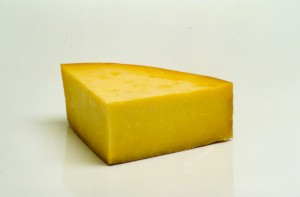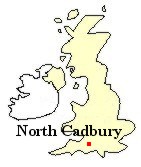
|
|
|||||
Cheddar is one of the most famous of all cheeses It takes its name from the village of Cheddar in Somerset where the cheese was first made. However, to be called a cheddar a cheese need only employ the making process called 'cheddaring'. Cheddar cheese is made with fresh morning milk mixed with the previous evening's milk. A lactic starter is added to promote souring, and then rennet is added to cause the milk to coagulate and to form a curd. The curd is then cut into cubes and the mass is heated and held at a temperature just above blood temperature, for thirty to fifty minutes. It is then allowed to settle and the whey is run off. The remaining, drying curds starts to matt together and the mass is cut into slabs, which are then repeatedly turned to help remove more of the liquid whey. This turning process is known as 'cheddaring'. When enough whey has been discharged the curd is then milled, salted and packed into cloth lined metal moulds. They are pressed for a day or more and then removed from the moulds to be wrapped in cheesecloth and then moved to the maturing room. The atmosphere in the maturing room is both cool and humid and the cheese sits here from six months to two years. The majority of cheddar is now made on a factory scale. Huge automated machines are used which can cheddar 14 tonnes of cheese in two hours. The curds are milled, salted and pressed into square moulds to produce block cheddar. Almost all the work from the emptying of the road tankers carrying milk to the final blocks of cheese leaving the factory, is done by machine and in only a few hours. The blocks of cheese are wrapped in plastic and matured for only a couple of months. This modern method of manufacture has led to a lowering in the costs of making cheddar: the high cost of labour is drastically reduced; high levels of stock maturing for long periods of time tying up capital is avoided; plastic wrapping avoids moisture loss and since cheese is sold by weight, the moisture is valuable to the makers. The real hand-made cheddars are far superior to the factory made alternatives and available to those who are prepared to pay the extra. Of course, factory cheddar is fine for topping ready made meals & basic sandwiches, but for the cheese-board no less than a real Cheddar is acceptable. The making of real farmhouse cheddar is now restricted to a hand full of farms, and the traditional unpasteurised cheese is only made on three farms. Ours is made by the Montgomerys' who have been making the cheese at Manor farm for generations. Their cheese-maker Harold was making the cheese at the farm for forty years, and in the later years with his son Michael. Harold has recently retired, but fortunately his son Michael has continued with the help of a new cheese-maker called Stephen. Montomerys' cheddar can be matured for 18months to produce a full nutty flavour and a dry texture. However, at the Teddington Cheese we prefer to mature the cheese for 12 to 14 months where the full nutty flavour is accompanied by a slightly moister texture. On stripping away the cheese-cloth and cutting open the cheese the most amazing aroma fills the room and the first taste of each and every cheese is one of the highlights of being a cheese-monger. Each cheddar truckle is approximately 40cm in diameter, 30cm high, 25kg in weight and has a fat content of 48%. When smoking a cheddar it is not possible to smoke a whole truckle as one piece. The flavours can only penetrate a small way into the cheese. For this reason the cheese is cut into 16 wedges of equal size and then placed into an oak fired smoke house for 6 hours. The resulting cheese has a full smoky flavour and aroma which complements the full nutty flavour of the cheese. The paste is moist, as with the unsmoked cheese, and the yellow colour is tinged with brown on the inside. The outside of the cheese has a fabulous chestnut brown colour and an intense smoky flavour. Click here or press your 'Back' button to return |
|
|||||
| All articles © www.teddingtoncheese.co.uk | ||||||
